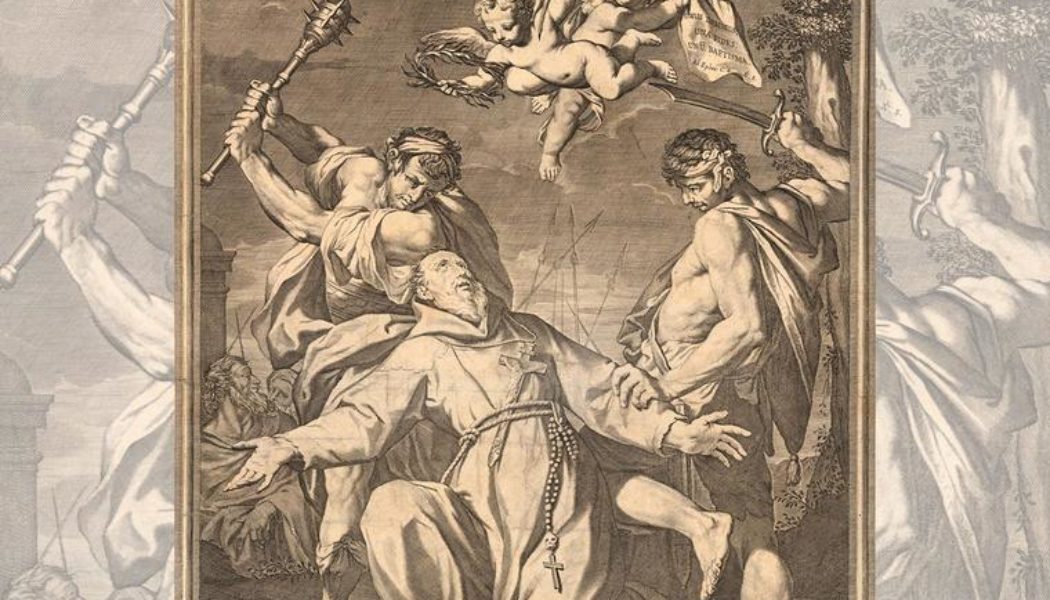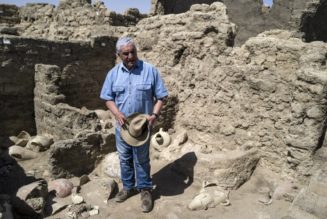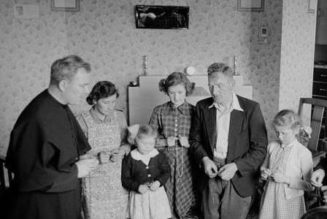
SAINTS & ART: St. Fidelis accepted the crown of martyrdom after he was given a choice of renouncing the Catholic Church or being killed.
When I lived in Switzerland about a decade ago, our family took a trip to the neighboring German state of Baden-Württemberg to see two places: the Benedictine abbey in Beuron, which had given birth to a school of Christian art in the late 19th century, and a quaint little town called Sigmaringen, in the hope of finding something about local-boy-made-beatifically-good, St. Fidelis. We batted .500: a rich visit in Beuron, but perhaps my German was not good enough to find much in Sigmaringen.
St. Fidelis was born Mark Rey in Sigmaringen in 1577, the son of a city official. He eventually studied at the University of Freiburg (German, not Swiss), working at first as a tutor and then as a lawyer. Encountering corruption in the courts, he accepted his priestly vocation (together with his brother, George), was ordained around 1612, and then professed as a Capuchin friar in Freiburg, taking the name Fidelis. After completing his novitiate, he finished theological studies in Konstanz in neighboring Switzerland. His reputation for zeal and piety led to his choice for several leadership roles in his order. He excelled in the pulpit and was much in demand as a preacher.
Consider the world in which St. Fidelis lived. The “Germany” of his day was not one country: it was a patchwork of local entities bound loosely under the headship of the “Holy Roman Empire.” By the time St. Fidelis came on the scene, Germany has been divided religiously by Lutheranism for nearly a century.
Few people know that the Reformation in Switzerland was even more divisive and radical. In Germany, Protestants advanced by leveraging support from local political leaders like princes; in the case of Switzerland, they did so canton-by-canton. The Protestant Reformation in Switzerland was also theologically much more radical than in Germany: Ulrich Zwingli, who set off Protestantism in Zürich, attacked Luther for not going far enough. While the convulsions of Germany’s religious Thirty Years War was still in the future (1618-48), Switzerland had already suffered conflict in the two Wars of Kappel (1529-31), during which Zwingli was killed. Jean Calvin had also already established his own sect in Geneva, which he turned into a theocracy: his theological children would eventually include the Puritans and strict Presbyterians. St. Fidelis was living on the front lines of multiple religious divisions in the Germanic world. (Austria had largely remained Catholic.)
But the Reformation also led to reform and recovery movements in the Church, including new religious orders. The Capuchins themselves were a relatively new order, sprung less than a century earlier from the great Franciscan trunk. They had expanded rapidly, had some presence in Switzerland, and were busy establishing themselves in Germany.
St. Fidelis worked to bring people back to the faith, both through his preaching and by his writings. In 1621, in response to an earlier request from the Bishop of Chur for Capuchins to attempt to convert what today is called the Canton of Graubünden or Grisons back to Catholicism, St. Fidelis went to work. Arriving in Advent 1621, he preached indefatigably across the rugged terrain of that northeastern part of Switzerland that today borders Liechtenstein and Austria. He continued his work throughout that winter, making several prominent converts, culminating in an intense work period throughout Lent 1622. Returning temporarily to his monastery in Feldkirch (Austria) for Easter, he was back in Graubünden by mid-April, where death threats against the Capuchins were already becoming vocal. (They were also accused of collaborating with the Austrians to subjugate Switzerland, a sensitive point of national pride since William Tell.)
In late April 1622, St. Fidelis began preaching in Seewis im Prättigau, where a disturbance ensued and he himself was shot at. When he emerged from the church, he noted that some people had already been killed. Offered asylum by one Protestant, he declared his life was in God’s hands. He then was given a choice of renouncing the Church or being killed. When he refused, he was clubbed to death and stabbed, one of his legs cut off. It is said that the Zwinglian minister who took part in his martyrdom subsequently repented and returned to the faith. St. Fidelis was canonized around 1745.
An Italian engraved print by Andrea Bolzoni (1689-1760) from the early 18th century depicts the martyrdom of St. Fidelis. The saint is in the middle, on his knees, in his Capuchin habit. His two murderers are on his right and left, the former wielding a club (St. Fidelis is often depicted iconographically with a head wound), the latter a sword. In the background we see the pikes of a mob. Two angels descend from heaven, bearing a crown of victory (2 Timothy 4:7-8) for the martyr who, in his name and by his actions, remained faithful.
Bolzoni produced a number of prints of saints. This print is held by the British Museum but is not on display.
St. Fidelis, with his fidelity to the true faith, is a marvelous patron for the local Church in today’s Germany and Switzerland.
(For more information, from which this essay is drawn, see here, here, here, and here).






